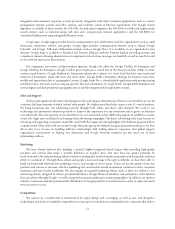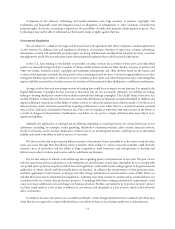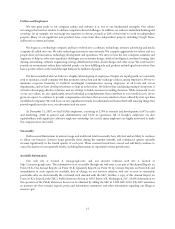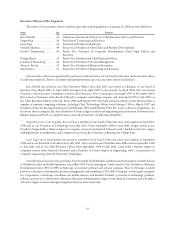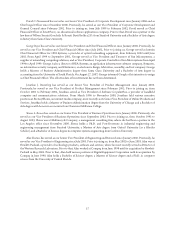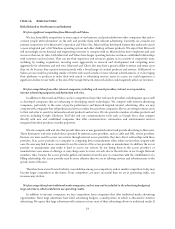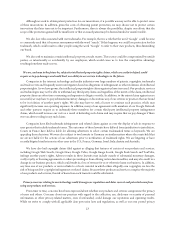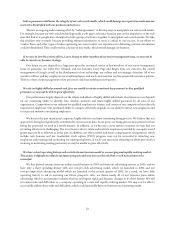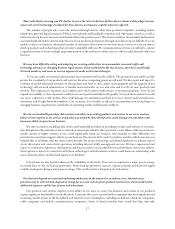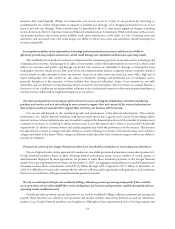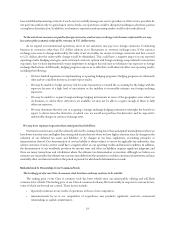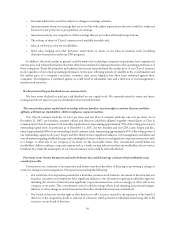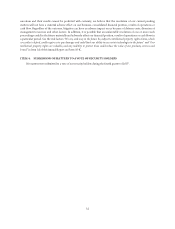Google 2007 Annual Report Download - page 36
Download and view the complete annual report
Please find page 36 of the 2007 Google annual report below. You can navigate through the pages in the report by either clicking on the pages listed below, or by using the keyword search tool below to find specific information within the annual report.and our ability to manage our business and conduct our operations internationally requires considerable management
attention and resources and is subject to a number of risks, including the following:
• Challenges caused by distance, language and cultural differences and by doing business with foreign agencies
and governments.
• Difficulties in developing products and services in different languages and for different cultures.
• Longer payment cycles in some countries.
• Credit risk and higher levels of payment fraud.
• Currency exchange rate fluctuations.
• Foreign exchange controls that might prevent us from repatriating cash earned in countries outside the U.S.
• Import and export requirements that may prevent us from shipping products or providing services to a particular
market and may increase our operating costs.
• Political and economic instability.
• Potentially adverse tax consequences.
• Higher costs associated with doing business internationally.
In addition, compliance with complex foreign and U.S. laws and regulations that apply to our international
operations increases our cost of doing business in international jurisdictions and could expose us or our employees to fines
and penalties. These numerous and sometimes conflicting laws and regulations include import and export requirements,
content requirements, trade restrictions, tax laws, sanctions, internal and disclosure control rules, data privacy
requirements, labor relations laws, U.S. laws such as the Foreign Corrupt Practices Act, and local laws prohibiting corrupt
payments to governmental officials. Violations of these laws and regulations could result in fines, criminal sanctions
against us, our officers or our employees, prohibitions on the conduct of our business and damage to our reputation.
Although we have implemented policies and procedures designed to ensure compliance with these laws, there can be no
assurance that our employees, contractors or agents will not violate our policies. Any such violations could include
prohibitions on our ability to offer our products and services to one or more countries, and could also materially damage
our reputation, our brand, our international expansion efforts, our ability to attract and retain employees, our business and
our operating results.
Our corporate culture has contributed to our success, and if we cannot maintain this culture as we grow, we could lose
the innovation, creativity and teamwork fostered by our culture, and our business may be harmed.
We believe that a critical contributor to our success has been our corporate culture, which we believe fosters
innovation, creativity and teamwork. As our organization grows, and we are required to implement more complex
organizational management structures, we may find it increasingly difficult to maintain the beneficial aspects of our
corporate culture. This could negatively impact our future success.
Our intellectual property rights are valuable, and any inability to protect them could reduce the value of our
products, services and brand.
Our patents, trademarks, trade secrets, copyrights and other intellectual property rights are important assets for us.
Various events outside of our control pose a threat to our intellectual property rights as well as to our products and
services. For example, effective intellectual property protection may not be available in every country in which our
products and services are distributed or made available through the internet. Also, the efforts we have taken to protect our
proprietary rights may not be sufficient or effective. Any significant impairment of our intellectual property rights could
harm our business or our ability to compete. Also, protecting our intellectual property rights is costly and time consuming.
Any increase in the unauthorized use of our intellectual property could make it more expensive to do business and harm
our operating results.
22


